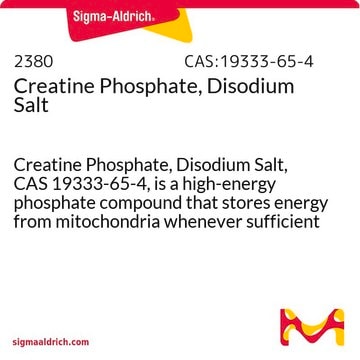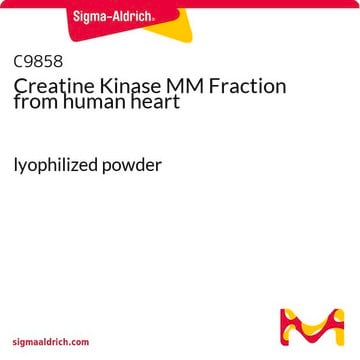C7886
Creatine Phosphokinase from bovine heart
Type III, salt-free, lyophilized powder, ≥30 units/mg protein
Sinonimo/i:
ATP: Creatine N-Phosphotransferase, CPK, Creatine Kinase, Phosphocreatine phosphokinase
Scegli un formato
Scegli un formato
About This Item
Prodotti consigliati
Origine biologica
bovine heart
Descrizione
Contains primarily isozyme MM
Tipo
Type III
Stato
salt-free, lyophilized powder
Attività specifica
≥30 units/mg protein
PM
80 kDa
Temperatura di conservazione
−20°C
Descrizione generale
Creatine phosphokinase (CPK) is an intracellular enzyme found predominantly in skeletal muscle, brain, and myocardium.[1] CPK consists of two polypeptide subunits, namely M (muscle type) and B (brain type). The lighter subunit is present in larger amounts.[2] The genes encoding these subunits are on distinct chromosomes, with B on 14q32 and M on 19q13. These subunits facilitate the development of three tissue-specific isoenzymes: CPK-MB (cardiac muscle), CPK-MM (skeletal muscle), and CPK-BB (brain).[3]
Applicazioni
- in the reaction mix for the import of in vitro synthesized wild-type FLAG/MYC-tagged LYR Motif Containing 7 (LYRM7-F/M) or the LFK tripeptide replaced with alanine (LFK-AAA) mutant into isolated mitochondria[4]
- in autoubiquitination assay[5]
- in the preparation of premix buffer for adenylyl cyclase activity[6]
- in the preparation of E-mix for in vitro nuclear assembly and isolation[7]
- in in vitro vesicular fusion assay.[8]
- in ATP regeneration system, to facilitate the reactivation of nonmotile axonemes.[9]
- in subcellular in vitro fusion assay of autophagosome with lysosome.[10]
- in in vitro protein translation assay.[11]
- for tATPase assay of myofibrillar protein isolated from rabbit. This assay evaluated the kinetic influence of bound creatine kinase (CK) on Ca2+-activated myosin ATPase.[12]
- for the enzymatic hydrolysis of protein samples during tryptophan estimation by pyrolysis gas chromatography.[13]
Azioni biochim/fisiol
Avvertenza
Definizione di unità
Risultati analitici
Codice della classe di stoccaggio
11 - Combustible Solids
Classe di pericolosità dell'acqua (WGK)
WGK 3
Punto d’infiammabilità (°F)
Not applicable
Punto d’infiammabilità (°C)
Not applicable
Dispositivi di protezione individuale
Eyeshields, Gloves, type N95 (US)
Scegli una delle versioni più recenti:
Certificati d'analisi (COA)
Non trovi la versione di tuo interesse?
Se hai bisogno di una versione specifica, puoi cercare il certificato tramite il numero di lotto.
Possiedi già questo prodotto?
I documenti relativi ai prodotti acquistati recentemente sono disponibili nell’Archivio dei documenti.
I clienti hanno visto anche
Filtri attivi
Il team dei nostri ricercatori vanta grande esperienza in tutte le aree della ricerca quali Life Science, scienza dei materiali, sintesi chimica, cromatografia, discipline analitiche, ecc..
Contatta l'Assistenza Tecnica.













